#Literary allusion
Text
Shakespeare's Cymbeline obviously has some story elements in common with Snow White. A princess heroine, a wicked queen stepmother, a servant is ordered to kill the princess but instead lets her go, she finds the home of some men in the wilderness and lives with them, but then she succumbs to "poison" from her stepmother and is mourned as dead, yet she isn't really dead, and eventually there's a happy ending.
In the play, the character of Belarius, the foster father who takes Imogen in (and whose foster sons turn out to be her long-lost brothers), goes by the pseudonym Morgan.
In the Let's Pretend radio adaptation of Snow White (or rather Snowdrop, as it's called), the leader of the seven dwarfs, basically a more dignified version of Disney's Doc, is named Morgan.
I see what you did there, Nila Mack. I see what you did there.
#william shakespeare#cymbeline#snow white#fairy tale#let's pretend#radio#nila mack#literary allusion#shout out to shakespeare
21 notes
·
View notes
Note
Hello! Love your blog :) Hoping you can help me with a quick q. On page 269 of The Slippery Slope, Violet, Klaus and Quigley discover the VFD motto ‘the world is quiet here’ but the narrator (Lemony) describes ‘four tiny words etched over their heads’, not five. Do you think this is a mistake, or is he leaving one out (e.g: ‘the’), or is he deliberately misquoting? The motto is derived from the first line of the Algernon Charles Swinburne poem The Garden of Proserpine: ‘Here, where the world is quiet;’ — so should the real interpretation of the motto be ‘the world is quiet’? Interested to hear your thoughts, thanks!
Hi, @sianitha, thanks for the ask (my Very First Discussion)!
It's definitely an interesting question, for which there can be a few theories:
Lemony is lying, for some bizarre reason.
Lemony is referring to The Garden of Proserpine when he means the actual emblazoned motto.
Either the word 'Here' or the word 'The' got burned from the fire, and Lemony is right.
It's an unnoticed editorial mistake.
Let's see. We know none of it is burned, as Quigley read all five words out.
Lemony is lying, for some bizarre reason.
Lemony is referring to The Garden of Proserpine when he means the actual emblazoned motto.
Either the word 'Here' or the word 'The' got burned from the fire, and Lemony is right.
It's an unnoticed editorial mistake.
Lemony is known for being a bit of a liar, but I think he tells mostly half-truths - when necessary - simply because he can't trust anyone, after having gone on the lam. But in this context, it's unnecessary; he's writing these books to clear his name and the Baudelaires' names, what good would it do him to lie?
Lemony is lying, for some bizarre reason.
Lemony is referring to The Garden of Proserpine when he means the actual emblazoned motto.
Either the word 'Here' or the word 'The' got burned from the fire, and Lemony is right.
It's an unnoticed editorial mistake.
Also, as a volunteer, he'd know his poetry pretty well; well enough to distinguish it from the organisation's motto, even if it is similar.
Lemony is lying, for some bizarre reason.
Lemony is referring to The Garden of Proserpine when he means the actual emblazoned motto.
Either the word 'Here' or the word 'The' got burned from the fire, and Lemony is right.
It's an unnoticed editorial mistake.
And this makes sense when you look at other typos, such as...
...well, as far as I remember, there was one in TPP about Klaus and "her sisters", or something to that effect.
As for the interpretation of the motto, I think it means
"THE WORLD IS QUIET HERE"
i.e. Wherever there is a branch of the V.F.D., the world THERE is quiet. Elsewhere, it's noisy and uncouth.
Hope that helps,
¬ Th3r3534rch1ngr4ph, Unfortunate Theorist/Snicketologist
***EDIT: There's also a fifth option which I hadn't thought of when writing this - the motto reads "THE WORLD'S QUIET HERE". But this also doesn't follow, as Quigley read out 5 words, not 4.***
#asoue#vfd#lemony snicket#a series of unfortunate events#snicketverse#theory#the world is quiet here#the slippery slope#the garden of proserpine#Algernon Charles Swinburne#first ask#very first ask#violet baudelaire#quigley quagmire#quiglet#quiglet shipper#quiglet forever#literary allusion
29 notes
·
View notes
Text
There's an implicit understanding between us that we . . . can share some personal information/vision best by swapping favorite epigrams and poems.
Chris Kraus, from I Love Dick
#literary#quotations#literary allusion#allusion#communication#kindred spirits#epigrams#poems#quotes#lit#words#excerpts#quote#literature#relationship dynamics#chris kraus#i love dick
13 notes
·
View notes
Text
Ode on a Grayson Perry Urn
Tim Turnbull (after Keats)

Hello! What's all this here? A kitschy vase
some Shirley Temple manqué has knocked out
delineating tales of kids in cars
on crap estates, the Burberry clad louts
who flail their motors through the smoky night
from Manchester to Motherwell or Slough,
creating bedlam on the Queen's highway.
Your gaudy evocation can, somehow,
conjure the scene without inducing fright,
as would a Daily Express exposé,
can bring to mind the throaty turbo roar
of hatchbacks tuned almost to breaking point,
the joyful throb of UK garage or
of house imported from the continent
and yet educe a sense of peace, of calm -
the screech of tyres and the nervous squeals
of girls, too young to quite appreciate
the peril they are in, are heard, but these wheels
will not lose traction, skid and flip, no harm
befall these children. They will stay out late
forever, pumped on youth and ecstasy,
on alloy, bass and arrogance, and speed
the back lanes, the urban gyratory,
the wide motorways, never having need
to race back home, for work next day, to bed.
Each girl is buff, each geezer toned and strong,
charged with pulsing juice which, even yet,
fills every pair of Calvin’s and each thong,
never to be deflated, given head
in crude games of chlamydia roulette.
Now see who comes to line the sparse grass verge,
to toast them in Buckfast and Diamond White:
rat-boys and corn-rowed cheerleaders who urge
them on to pull more burn-outs or to write
their donut Os, as signature, upon
the bleached tarmac of dead suburban streets.
There dogs set up a row and curtains twitch
as pensioners and parents telephone
the cops to plead for quiet, sue for peace -
tranquillity, though, is for the rich.
And so, millennia hence, you garish crock,
when all context is lost, galleries razed
to level dust and we're long in the box,
will future poets look on you amazed,
speculate how children might have lived when
you were fired, lives so free and bountiful
and there, beneath a sun a little colder,
declare How happy were those creatures then,
who knew the truth was all negotiable
and beauty in the gift of the beholder.
#poetry#tim turnbull#john keats#grayson perry#grecian urn#grayson perry urn#cars#commentary#status#class#social commentary#literary allusion#art#britain
3 notes
·
View notes
Text
One of my flaws is pointing out every allusion to literature in a show that I notice
#bookish#booklr#books#bookworm#books and reading#book thoughts#bookblr#literature#literary allusion#allusion
1 note
·
View note
Text
Okay, here we go. Rating literary allusions in Taylor Swift songs:
The Outside: "I tried to take the road less traveled by /but nothing seems to work the first few times/am I right?"--Starting off pretty well! She tried to take the road less traveled by, but it didn't make any difference. 8/10
Love Story: Whole song allusion to Romeo and Juliet-- All those 2008 jokes about Taylor not having read R&J weren't funny then and they aren't funny now. It's a fun, satisfying subversion. However, I am going to dock points for the fact that Romeo and Juliet aren't a prince and princess, just rich. 7/10
Love Story: "You were Romeo/I was a scarlet letter"--Is the Juliet character in "Love Story" being publicly shamed? Did she do something scandalous? There are zero other lines in this song to suggest that she did, and a fair amount of evidence that she didn't. This allusion confuses rather than clarifies and tbh this is the one people should've made fun of in 2008. 2/10
New Romantics: "We show off our different scarlet letters/ trust me, mine is better" --Hooray! She figured out what the book is about! This is a beautifully executed allusion, where "scarlet letters" represents a mark of something shameful which, in a fun subversion, is being shown off with pride. Fits the song really well. Most improved award, 11/10
Getaway Car: "It was the best of times, the worst of crimes" (A Tale of Two Cities) -- Goes in the category of "fun wordplay, but doesn't really mean anything deeper" 5/10
This Is Why We Can't Have Nice Things: "Feeling so Gatsby for that whole year" --This is a perfectly serviceable allusion, but not a super interesting one. Sub "Gatsby" out with "nostalgic" and the song wouldn't change at all. She could've done a lot more with the reference, given the subject matter of the song. 6/10
cardigan: "I knew you/tried to change the ending/Peter losing Wendy" -- This works! You get a sense of Betty losing her innocence and choosing to leave James and of it being inevitable somehow. Plus, it imbues the song with a lovely fairy tale quality. 10/10
illicit affairs: "take the road less traveled by/tell yourself you can always stop" -- To take the road less traveled by is to do something risky, unpopular, or unfamiliar, not just to take a route through town where you won't run into people. Not totally egregious, but the regression from Debut is disappointing. 4/10
invisible string: "and isn't it just so pretty to think/ that all along there was some/ invisible string tying you to me."(The Sun Also Rises)--Ugggggh. Okay, so "Isn't it pretty to think so?" is this sad, tired, ironic note in The Sun Also Rises. Brett tells Jake, "We could have had a damned good time together" and Jake says "Isn't it pretty to think so?" because their whole situationship was never going to work. It's not a positive thing; it's pure, bitter Lost Generation irony. Completely out-of-place in a song about how two people we're supposed to believe will actually work as a couple. This one drives me nuts, and I don't even like Hemingway. 0/10
happiness: "I hope she'll be a beautiful fool/ who takes my spot next to you" (Gatsby)--Saying this about an ex's future SO is so... off. Like, the reason why Daisy hopes her daughter will be a beautiful fool is because it's easy. The two situations have nothing to do with one another, and not in an interesting way. 1/10
The Albatross: whole song allusion to "The Rime of the Ancient Mariner," but most notably "She's the albatross/ she is here to destroy you"--The albatross in the Rime is a good omen. The Mariner shoots is for no reason, and the albatross's death is the ostensible source of bad fortune. I wrote a whole separate post on this here. That said, culturally "albatross=bad omen" is common enough, so whatever. 3/10
I Hate It Here: "I will go to secret gardens in my mind/ people need a key to get to/ the only one is mine" -- I like this one a lot. Exactly the right vibe for the song, trying to escape something miserable by going somewhere pleasant. The key is a nice touch. Poor Archibald. 10/10
The Prophecy: "I got cursed like Eve got bitten" --No Taylor, that's not what happened. Famously, Eve was the biter in that situation. 0/10
Cassandra: whole song allusion -- correct me if I'm wrong (I haven't actually read the Illiad), but my understanding is that Cassandra died fairly far into the Trojan war, and not by burning. 4/10
#this probably isn't exhausive lol#but it's what i've got off the top of my head#this was weirdly cathartic to write#you guys know i adore taylor swift but literary allusions have always been my biggest nitpick with her#i would just like to send her to an English class or gently help her out or something idk#tay tay#i'm aware that i'm not addressing Peter off ttpd but that song is such a nothingburger that i really can't be bothered#pontifications and creations#literature makes us more human
66 notes
·
View notes
Text

In one of the weirder Pokemon references, the French names of Basculin and Basculegion are Bargantua and Paragruel, respectively, in reference to Rabelais' giants Gargantua and Pantagruel.
#today in deep literary pokemon allusions#pokemon#rabelais#gargantua#pantagruel#16th century humanists? in MY monster collecting video game?#it’s more likely than you think
80 notes
·
View notes
Text
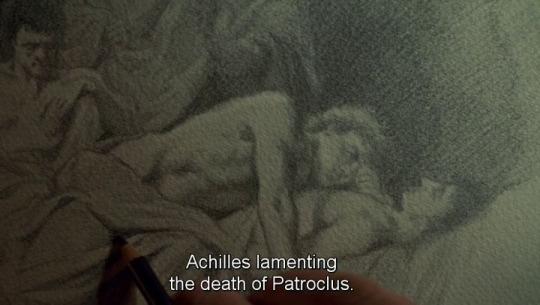
The lovers
He is half of my soul as the poets say-
#hannigram#murder husbands#nbc hannibal#shattering teacups#literary reference#religious allusion#mythology#Patroclus and Achilles#literature#the Iliad#classical literature
26 notes
·
View notes
Text
Ah, the importance of local journalism! Our correspondent covering the weekend news in Whitby is full of news about the extraordinary storm that brought in the Demeter, ‘as idle as a painted ship upon a painted ocean.’
Now. We know that our correspondent, besides being a fairly good runner, has a taste for flowery description and literary allusion, like many another Victorian journalist. But this line of poetry is not merely proving his education. It is taken from Coleridge’s Rime of the Ancient Mariner. And The Rime of the Ancient Mariner is about a ship which is pursued and haunted by an evil spirit, in which corpses are reanimated, and in which evil has power that even the wind and the waves obey. The thing which pursues the ship brings death, and madness, and things worse than both.
#dracula daily#angst and literary allusions#bram stoker#not normal even once#the rime of the ancient mariner#the very deeps did rot: o christ! that ever this should be!
528 notes
·
View notes
Text
Fucking love fandoms of stuff based on Christian mythology because you get folks who in the interest of creating more accurate nuanced fanfiction and theories about their biblical blorbos will straight up become scholars of theological texts for funsies
#bitches will be like ‘we’re trying to analyze and figure out if this Uberangel Dave is the same as the Uberangel Dave in the Bible 2#or if she’s actually a representation of this other dude from the secret diary of this 14th century monk that became classic lit in France’#AND I EAT IT UP EVERY TIME#I am. fucking OBSESSED with cross referencing shit for literary allusions & what those allusions suggest about how to read the themes & plot#the stuff about Pride & Prejudice alone in Good Omens 2 has KILLED ME#I would’ve been an english major if I didn’t find drawing easier than writing essays#spilling the Tea#good omens#supernatural#spn
59 notes
·
View notes
Text
Pat's Shirts: An Extended Analysis
Since Bad Buddy's on the brain, I'd like to present an analysis of a show through a Pat's-shirts-centered critical lens.
Literature review: Many very smart people that I will try to link to have analyzed Bad Buddy through this lens already, but I would like to contribute to the discussion, specifically focusing on the iconography and text on the shirts. For great analysis that also incorporates colour, look to @dribs-and-drabbles whole series (x). Thesis statement: Pat's shirts convey his inner thoughts directly to the audience, generally going unnoticed by other characters, like a soliloquy. They provide insight into his emotional state and aspirations as they shift throughout the stages of his narrative arc.
Pran is more reserved about his feelings, and often expresses them through external signs such as the smiley face on his door. Pat can also be interpreted through the same lens, using external signifiers such as t-shirts to show what he is thinking. Pat is so expressive that he needs to literally wear his feelings on his sleeve (or chest).

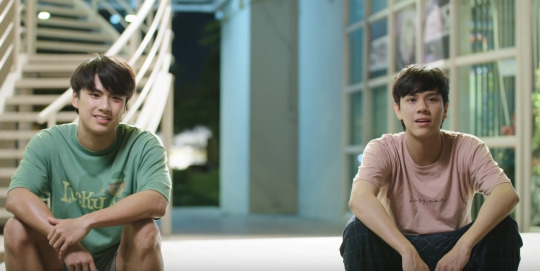
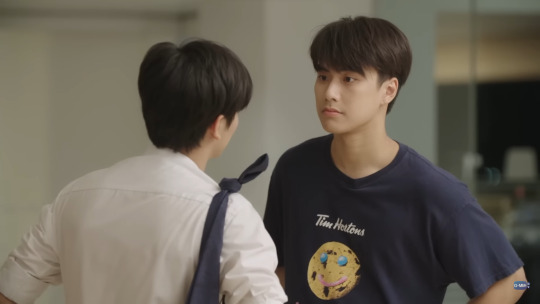
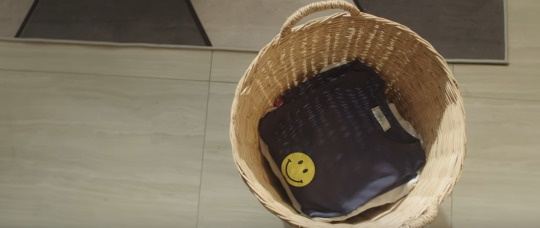
In the first several episodes, there is a sense of optimism and possibility. In episode 1, Pat wears a shirt that reads "turn up the saturation" while talking with Pa in his old room. He looks over at Pran's house, Pran obviously on his mind. This showcases how things are just getting started. His feelings for Pran have been reignited after seeing him on campus. Pat wants to turn up the saturation in his life, make it more vivid, and already he's connecting that sentiment to Pran.
The feeling of hopefulness continues when Pat wears his Lucky (Charms) shirt. When their friends get into another fight, while Pat's wearing this shirt, his professor tells them they're lucky no one got seriously hurt, but there's more luck at play in this moment; they're lucky that they have found each other and are in each other's lives again. They have their first real conversation while they're patching themselves up, where they decide to work together to stop their friends from fighting and exchange chat IDs. Things are (slowly) starting to come together.
Pat next wears a Tim Hortons shirt from the Smile Cookie charity campaign. This is an interesting adaptation of Pran's signature motif, Pat mirroring the smiley faces that Pran surrounds himself with. Pat wears this shirt when they eat together at the food truck, so the food-related shirt is thematically relevant, especially one associated with sharing and giving. Pat and Pran share food (or more accurately, Pat steals Pran's wonton) but it’s a playful moment that they'll return to later in the show when Pran gets an extra wonton for Pat to steal. The shirt represents Pat's happiness at being close to Pran again, at being back in the game they play.
The optimism embodied in these shirts is also reflected in a shirt that Pat doesn't wear yet, but is instead hinted at. On top of Pat's pile of laundry is another smiley face shirt that he will wear five years later in the finale. Pat holds onto this shirt that represents Pran and his aesthetic, long before they start dating. The teasing of this shirt is the ultimate symbol of optimism, brimming with possibility.

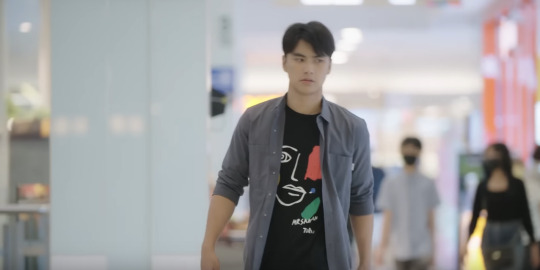

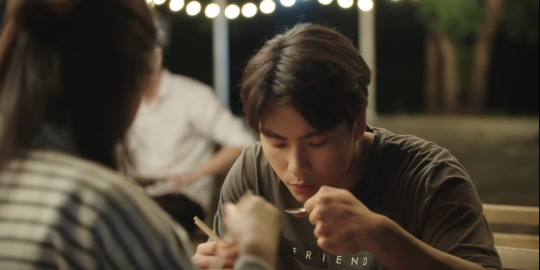
We then move on to Pat's confusion and realization arc. The first shirt I'd like to discuss is the Salome shirt he wears at the photoshoot with Ink. There are two literary and artistic references here: Salome, the biblical story and its adaptations, and Picasso's painting of his close friend Jaime Sabartés.
Picasso painted many portraits of Sabartés, and dedicated many more to him, but this specific painting is from 1939, humorously portraying Sabartés as a sixteenth-century courtier. This might reflect Ink and Pat's relationship in this moment. Ink gives Pat this shirt, putting him into a costume like Picasso did with Sabartés, and there is an interesting juxtaposition between subject and artist at play.
Sabartés recalled about a previous painting, “When he put the painting up on the easel, I was astonished to see myself … the spectre of my solitude, seen from without.” About the 1939 painting, he wrote, "[it] has all the characteristics of my physiognomy, though only the most essential ones. If the way Picasso put them together does not coincide with the way the majority of people see them, this is because, thinking about me, he took them from his memory, with the intention of giving them form in a picture […] while people who look at me directly as I am forget me when they are trying to remember me." (x)
This is reminiscent of the way that Ink seems to knows Pat's feelings maybe more than he knows himself and her lack of surprise that Pat and Pran get along. From her perspective, they have always been friends. As artists, Ink and Picasso see their subjects in a different light. It is in direct relation to Ink that Pat comes to realize his feelings for Pran, by testing out Pa's patented technique. This whole situation discombobulates him, which is captured in Picasso's Cubist style.
The second aspect of the shirt is the biblical story of Salome. @dribs-and-drabbles (x) made the excellent connection between the femme fatale in this story to the faen fatale in Bad Buddy (Ink), although Bad Buddy explicitly subverts this trope. I also find it interesting that one of the most famous adaptations of Salome was written by Oscar Wilde, so some queer connection could be teased out. It is also worth noting that one of the themes of the play is the dangers of looking, especially since the shirt is worn during a photoshoot. Herod begs Salome to free him of his promise, apologizing for looking at her too much: "Neither at things, nor at people should one look. Only in mirrors should one look, for mirrors do but show us masks." Perhaps Pat can also be seen as wearing a mask, one he is not aware he is wearing all the time.
There seems to be little connecting Salome and Picasso that I could find, though both are playing with ideas of historical adaptation, from the biblical play to Sabartés in costume. Bad Buddy also toys themes of the past as Ink is introduced, casting new light both on Pat and Pran's historical relationship and their relationship now.
The next shirt is another one that is given to Pat. Pat borrows the friend/unfriend shirt from Pran when he sleeps over in Pran's room. They are figuring out how to relate to each other, and especially in this scene, how the other feels about Ink. Pat wears this shirt on a "date" with Ink at the food truck, another relationship that he is trying to determine how he feels. The friend/unfriend shirt reflects a pivotal question about Pat and Pran's relationship. They are not friends, but what does that make them instead? What is "unfriend", the negation of friend? Is it enemy? Is it lover? They both desperately need it to be something, to be in each other's lives in some way.
During and after his next "date" with Ink, Pat wears a black shirt with an abstract face on the front. This echoes the Cubist style of the Picasso shirt. However, in this design, the face is even more abstracted, configured with just a few white lines on a black background in unrealistic proportions. Just as the Picasso shirt implied Pat's burgeoning confusion, here he is slammed with the new revelation that he likes Pran as more than a friend. @dribs-and-drabbles pointed out the splash of red right over his heart, signifying his newly discovered feelings (x). This design is stark, impressionistic, boiled down to the bare essentials of a face and disassembled. Pat is taken apart and feeling lost knowing how much he wants Pran. The shirt speaks to the confusion Pat feels in this moment.
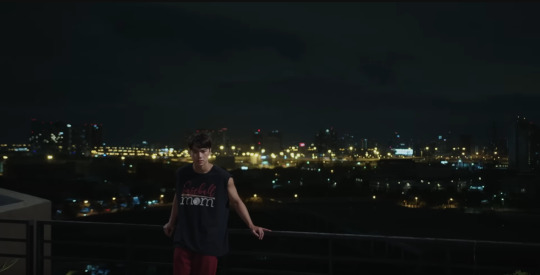
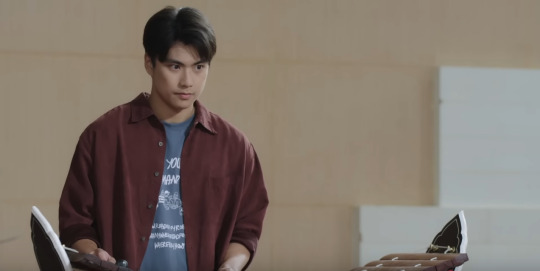
The next phase is about yearning and seeking connection. Pat knows how he feels about Pran; he has fallen, and fallen hard. Now that he has discovered this, he changes into the Baseball Mom shirt to tell Pran of his feelings on the rooftop. In this scene, Pat tells Pran he doesn't want them to just be friends, and through his shirt he tells Pran he sees a future with him. The shirt evokes a future of love and family (though not confined to the heteronormative idea of family). It is about closeness and partnership and possibilities.
During the flirt-off, Pat shows up to the Kwan and Riam audition with a blue shirt mostly covered by a burgundy button-up. The only clearly visible words are "YOUR / MAN?" This is a declaration, he wants to be with Pran. He's asking, can I be your man? as @dribs-and-drabbles writes (x). He's almost staking a claim on Pran, but subverts this by instead declaring himself to be Pran's, similar to when he cedes the competition to Pran.
Looking at the text more closely, however, a few words are visible. The shirt has a quote from On the Road by Jack Kerouac: "What's your road, man? - holyboy road, madman road, rainbow road, guppy road, any road. It's an anywhere road for anybody anyhow. Where body how?" Combining the full text and the selective framing visible on screen, Pat seems to be asking to go on this road together, wherever it may lead.

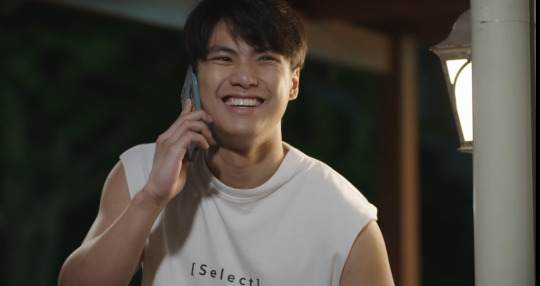
Once Pat and Pran start dating, Pat's shirts reflect the joys and tribulations of a newly established relationship. He wears the "Proud to be a [Noles] Hater" when practicing the play with Pran. Pride is written clearly on his chest, but it also hints to insecurities. Pat is being perhaps too proud for Pran, posting pictures on Instagram and flirting to openly. Moreover, this shirt is a reference to the sports rivalry between the University of Miami and Florida State University, and as the previous scene showed Pat playing rugby, the shirt signals the continuing rivalry between the architecture and engineering faculties. The theme of rivalry is also ever-present in their families' rivalry, which as @dribs-and-drabbles discusses (x), originated with university. This showcases that while Pat and Pran are happy together, there are external forces working against them.
After a tense argument with his father, Pat wears a white shirt with [SELECT] written on the front. In this scene, Pat is asking Pran to choose him—to select him. The framing of the text in square brackets is also reminiscent of a hyperlink or code, perhaps further emphasizing the act of clicking/selecting. He wants comfort from Pran but is unwilling to ask for it directly, to bother him with his problems. Pran hears the unspoken message and comes home to cheer Pat up, prioritizing him.

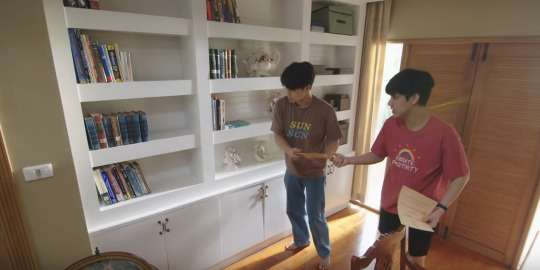
When Pat gets out of the hospital, Ming surprises them both by thanking Pran for helping Pat get his name cleared. During this scene, Pat wears his California shirt, which @karometeenk has deciphered. To summarize, it is a slogan for a German pharmacy that reads "Here I am human, here I shop" which is a play on the Faust quote which can be translated as "Here I am human, here I can / am allowed to be one" (full credit to @karometeenk for translation and analysis, along with @dribs-and-drabbles and @airenyah's discussion (x) (x) (x). There is something sinister underneath this message. This shirt alludes to Pat's desire to escape, to be free, but also signals the obstacles to this, especially as he wears this when talking to his dad, who seems to be behaving decently, but there will be future complications. The slogan appropriates a quote about one's humanity commodified to sell products, commercializing people's identity. While Pat and Pran are happy together, they cannot yet just be.
The theme of seemingly cheerful shirts with a sinister undertone continues later in the episode. Pat wears a shirt with the words "SUN SUN SUN", reflecting the happiness he feels to be with Pran, as well as directly mirroring Pran's "radiate positivity" rainbow shirt. Together they depict the sun emerging after a period of rain. However, the optimism conveyed by these shirts is undermined by the peril they find themselves in, the danger of getting caught in Pran's father's office and the looming revelations about their families' rivalry that could destroy their relationship. The storm is not yet over.

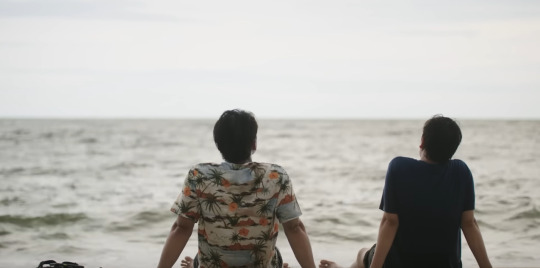


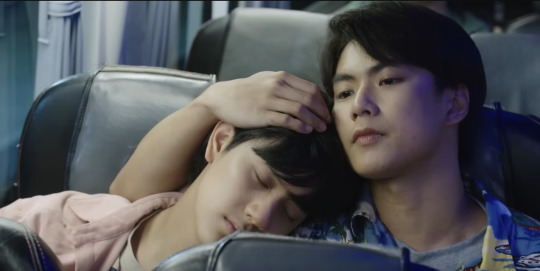
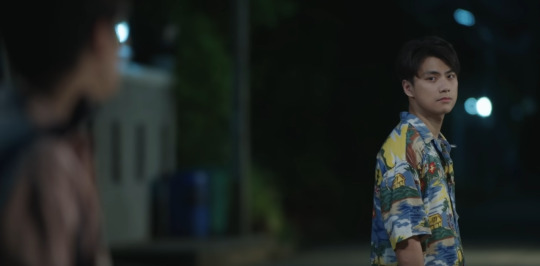
You may be wondering why I have skipped over a crucial subsection of Pat's wardrobe: his Hawaiian shirts. Fear not! I would like to discuss these shirts collectively, as they convey a similar theme that does not fall neatly into the chronology of the other shirts. They reflect an idea that the show keeps returning to every time Pat wears them. They stand outside of time.
These shirts symbolize hope and yearning, but they are often tainted by a feeling of despair and desperation. Dreams thwarted. These shirts are aspirational for Pat, conveying the sense of peace and freedom that he wants but cannot yet achieve. He often wears them in moments of crisis. In episode 5, Pat wears the blue pineapple shirt when he gets in the fight with Wai. He is seeking clarification about their relationship but winds up in a physical altercation and Pran leaves without giving him any answers.
He wears the Golden Gates Bridge shirt when he gets shot—this was a chance to reconcile their two friend groups, but it ends in disaster. However, in the end, that event literally builds bridges between them (I am including this shirt in this section though it may not be a Hawaiian shirt). The elephant shirt Pat dons in episode 11, as @dribs-and-drabbles has discussed (x), shows Pat wanting to forget, wanting to start anew on the beach with Pran without their families interfering, but the elephants belie this message as elephants never forget.
Pat wears a lot of Hawaiian shirts at the beach, both times. On the first beach trip, there is a feeling of opportunity, now that they have kissed. But at the same time, while Pat wants Pran to open up to him more, Pran is trying to protect himself. The beach symbolizes a chance at freedom, a chance to be open about their feelings. It makes sense that Pat would wear these shirts there. Except they are not confined to the beach, they traverse space and time.
I'd like to look specifically at the shirt Pat wears when he runs away. He is wearing it when his dad finds them together at the mall, and during the confrontation with both their parents. Here in the city it seems out of place, but it reflects Pat's desperation to love Pran freely, to escape the restrictions being placed on them. And then they do escape to freedom, to the beach where there is hope that they can be together, and Pat continues to wear the shirt. It depicts a dream that seems so close to being realized.
When they get back home, Pat is once again wearing the shirt he wore when they ran away. Nothing has really changed, despite their temporary escape, the same problems with their families persist. The repetition of the shirt brings this message home. But it also an interesting choice for both of them to wear the same shirts, it feels intentional. Like a disguise. They are going home, pretending that nothing has changed, that they broke up, but are keeping the truth hidden.

The shirt Pat wears in the finale is a callback to the first episode when we saw it in Pat's laundry basket. Pat has incorporated Pran's style into his own, reflecting smiles back at him. He wears it in front of his family, a hidden signal of their relationship. This shirt shows that the optimism of before paid off, that they can achieve the open-ended future they are fighting for. That there is hope.
#bad buddy#on this rewatch i analyzed the show using 2 critical lenses#1. literary allusions and queer theory#and 2. pat's shirts#how is this the longer meta of the 2 i wrote this weekend? it was supposed to be a joke#sometimes i just like to have thoughts recreationally#bad buddy series#bad buddy meta#bad buddy shirts#thinking thoughts#thai drama fashion#bad buddy the series
118 notes
·
View notes
Text
I have not stopped thinking about The Vampyre since I read it, so here's some extra trivia for y'all about Lord Ruthven's name:
VnC's Lord August Ruthven is, of course, named after the Lord Ruthven from the short story "The Vampyre." Written by John William Polidori and published in 1819, "The Vampyre" is often cited as the first piece of true modern vampire fiction. It makes sense for Mochijun to want to reference something so genre-founding.
However! The circumstances surrounding this short story (and thus the Ruthven character) are both deeply weird and deeply fascinating.
For starters, do y'all know the famous story about how Frankenstein was written? It started as a challenge between friends stuck inside due to bad weather—write a frightening story for everyone's entertainment. Mary Godwin (soon to be Mary Shelley) and her future husband Percy Shelley were there, of course, but so were the poet Lord Byron and his personal doctor: a man named John Polidori.
While Mary penned the beginning of one of the most famous books in history, Byron's own attempt at horror was abandoned partway through. He wrote a fragment of a novel about an aristocratic vampire and a foolish young man that traveled with him to Turkey, but he never inteded to finish it. However, after learning how Byron thought the tale would end, Polidori eventually came to write his own (complete) version of a similar plot.
The Vampire in Byron's fragment went by the name of Augustus Darvell, but for the majority of "The Vampyre," Polidori's titular monster calls himself Lord Ruthven. This name comes from the novel Glenarvon by Lady Caroline Lamb, a book that openly parodied and mocked Lord Byron (Lamb's ex lover) with its main character.
Now, why did Polidori name the monstrous, cruel, almost parasitic monster in his story after a parody of his patient and boss? That's because their relationship was deeply fraught. I am not the person to speak accurately on this history, so let it suffice to say that Polidori did not have a rose-colored image of Lord Byron.
Byron was famously promiscuous and often in terrible debt. He doesn't seem to have been particularly nice to his doctor. If you read about their time together in any detail, it becomes obvious why Polidori might feel the urge to mock him as a monster.
Polidori wrote a vampire that seduced, tore through, and ruined innocent young maidens. He wrote this after traveling Europe with a man who was forced to flee England with a rake's reputation and a charge of sodomy. He named his vampire Ruthven, after a caricature of Byron, because his own Ruthven was also based on the man.
In other words, the first finished story to create the modern trope of the aristocratic vampire was in large part a parody of Lord Byron. It is a monster inspired by him and named after a character that existed to sleight him. It is also based on a story that Byron wrote.
And in addition to this being generally fascinating, there's something so fun about this in the context of VnC.
The Case Study of Vanitas is its own story, but it's also so chock full of allusions and references that you could almost call it a pastiche. Half its characters are half-crafted out of pre-existing characters and historical figures, but they're only ever halfway stolen. There's always something new built from the base of the reference.
And in a big way, that's what Polidori did back when he penned the first piece of modern vampire literature. His first vampire was partly a reference to a real man, partly borrowed from a pre-existing story (Byron's fragment), and partly conjured from Polidori's own imagination. It's history and literature and new content all bundled together, just like VnC is.
Lord August Ruthven is a reference to Polidori's Lord Ruthven, who was in turn a reference to Lord Byron. He's named after both Byron's Augustus Darvell and Polidori's Ruthven, and Polidori's Ruthven is named after Lamb's Ruthven (who was also based on Lord Byron). He's yet another layer on this tower of self-referential Ruthven-ness, now totally abstracted from any real Byron traits.
As much as Mochijun is playing with the tropes and ideas of this era of vampire literature, it's really fun to see how her tendency toward allusion and reference is itself a nod back to vampire literature's beginnings. It's another way in which VnC slots in as another link in this 200 year old literary conversation.
Anyway, if you want to learn more about the bonkers story behind the Vampyre, here's a link to a not super scholarly but very entertaining essay about it.
#this is without a doubt the nerdiest post I've made on this blog lmao#I did a bunch of reading on polidori right after I finished the vampyre and I have not stopped thinking about it since#and the way that the story fits so well with mochijun's own referential tendencies in vnc genuinely brings me so much delight#it's fun having a manga that's engaging with a literary/cultural canon I've studied and am generally so familiar with#really helps with talking about the allusions lol#vnc#vanitas no carte#the case study of vanitas#august ruthven my beloved#august ruthven#lord august ruthven#comparison#noé arqueueviste
92 notes
·
View notes
Text
have you guys read nevermore (webcomic)? you should read nevermore
#it is the highest-quality webcomic i’ve ever read#it’s got literary allusions! ghosts! cryptids! manipulative sapphics! the mc is butch! animations + absolutely beautiful art in every panel#nevermore#nevermore webtoon#webcomics
53 notes
·
View notes
Quote
She made everything seem possible for him, she was like a thousand green lights in a row.
Joseph Knox, from True Crime Story
#the great gatsby#literary allusion#green light#promise#inspiration#possibility#muse#give me the green light#symbol#relationship#quotes#lit#words#excerpts#quote#literature#joseph knox#true crime story
9 notes
·
View notes
Text

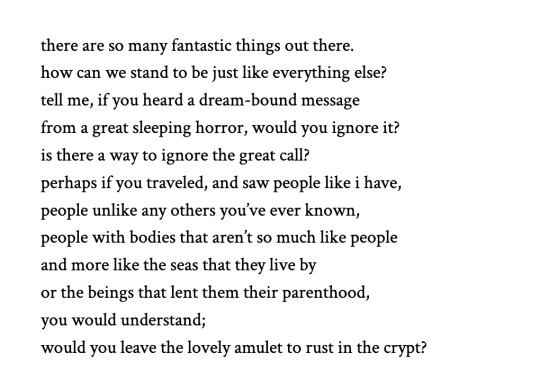

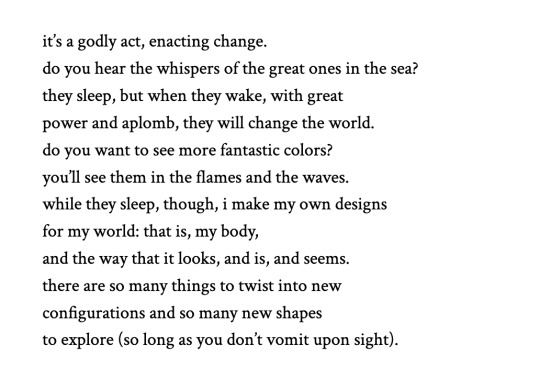
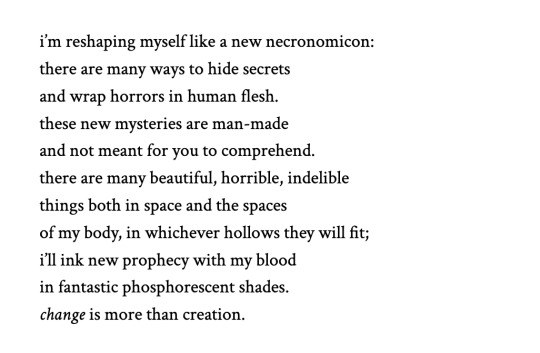
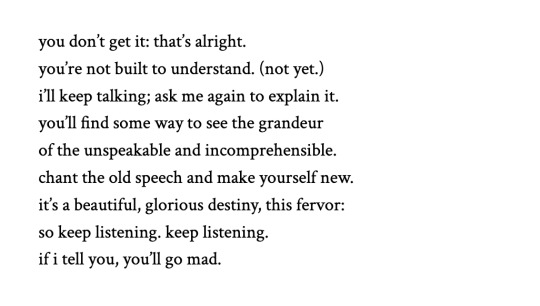
i checked out a book on gender theory from miskatonic university this one time // april 6 2023
#prompt: if i told you you'd go mad#getting transgender and lovecraftian with it!!! hell yeah these horrors are man-made. and well within my comprehension#poems about being trans#poems about being nonbinary#i need a tag for all my poetry with my silly little literary allusions. they're just so fun to me#escapril#napowrimo#poems and poetry#poets on tumblr#poetry#lovecraft#escapril 2023#lovecraftian#i like this one a lot actually. i have not even proofread it but the title has me immediately in love
94 notes
·
View notes
Text
Just finished the atlas complex and thought I'd pop in to revel in some dark academia done good tragedy but um. Nope. Seems that is NOT the general vibes around here. Rip to my hopes of finding fanart
#the atlas complex#rose rambles#rose reads#likr damn I'm sad and like emotionally processing the endings for ghem all#but also#they hit hard and it's dark academia#dark#like#tragedy#eith PLENTY of literary allusions to signify it ain't ending happily#and isn't that the message? the theme? the vibe?#that happiness is brief and it's hard and it's a choice and it's life and it's loss and struggling and choosing and choosing and choosing#and it's inanity#it's purpose and logic#and chaos and unfair and sudden and slow so slow and everything and never nothing but a facsimile of nothing that we fall into so easily#it's tragic#it was tragic#and i loved it#with my whole heart
11 notes
·
View notes